We all remember that catchy, finger-snapping theme tune crafted by Hollywood composer Vic Mizzy, instantly recognizable as the sound of The Addams Family. This iconic television show graced our screens from 1964 to 1966, delivering a total of 64 episodes centered around a delightfully morbid family who playfully (and sometimes unintentionally) terrified their neighbors. Characters like the suave Gomez, the elegant Morticia, the eccentric Uncle Fester, the doting Grandmama, the mischievous Pugsley, and the perpetually gloomy Wednesday became household names. For many, especially those who felt like outsiders, The Addams Family resonated deeply, portraying a family that reveled in their “weirdness” amidst a world striving for normalcy. The show, even decades later, remains fresh, hilarious, and endlessly interesting. Although its initial run was brief, lasting only two seasons, its legacy endured, spawning a one-season animated series by Hanna Barbera in 1973, featuring the unmistakable voice of Ted Cassidy as Lurch.
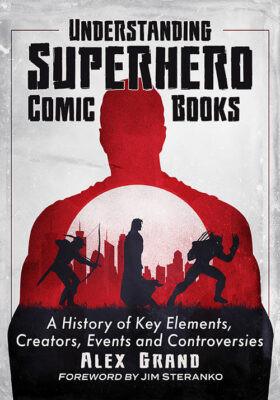
Book cover featuring a collection of superhero comic book covers, showcasing a resource for understanding superhero comic books.
The enduring appeal of The Addams Family led to numerous revivals and adaptations. In 1977, much of the original cast reunited for a Halloween reunion movie. While this colorized version offered a nostalgic glimpse of the beloved characters, it arguably lacked the unique charm of the black and white 1960s series. Nevertheless, seeing John Astin and Carolyn Jones reprise their roles as Gomez and Morticia was a treat for fans. The 1990s witnessed a significant resurgence with two critically acclaimed and Academy Award-nominated films, The Addams Family (1991) and Addams Family Values (1993). Starring Raul Julia and Angelica Huston, these movies presented an even darker and more sophisticated interpretation of the family, captivating a new generation of audiences.
The success of these films paved the way for a 1992 animated Addams Family series, which ran for two seasons and featured John Astin lending his voice once again, this time as Gomez. Tragedy struck with the untimely passing of Raul Julia in 1994, due to complications from stomach cancer, putting a halt to further films in that series. Despite this setback, the Addams Family returned in a 1998 straight-to-TV movie which, while not well-received, featured a memorable performance by Tim Curry as Gomez.
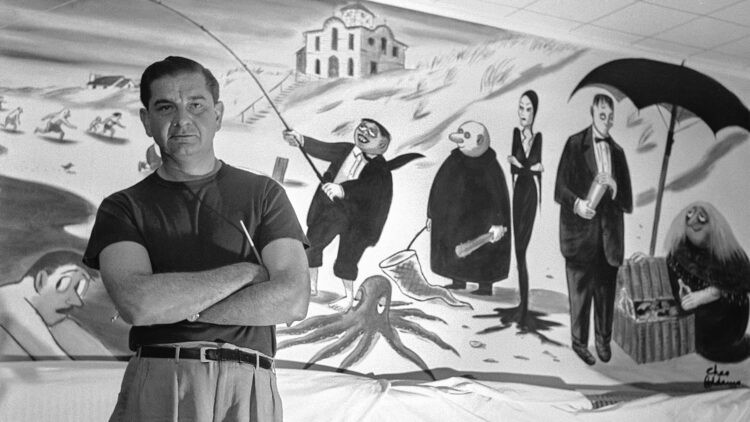
A black and white cartoon panel by Charles Addams, depicting a darkly humorous scene reflecting his signature macabre style.
The franchise faced further challenges with “The New Addams Family,” a series that aired on Fox Family in 1998 in both the USA and Canada, totaling 65 episodes. Neither this nor the TV movie managed to recapture the magic of earlier iterations, and the Addams Family lay dormant for a while until their revival as a musical in 2010, with Nathan Lane taking on the role of Gomez. Recognizing the enduring popularity and adapting to contemporary tastes, MGM, the copyright holder, released a CGI animated Addams Family movie in 2019, which proved to be a box office success. This modern animated version, along with its sequel, brought the characters to a new generation and underscored the timeless appeal of the Addams Family.
However, to truly appreciate the CGI films and all subsequent adaptations, it’s essential to understand that the visual style and character personalities are directly rooted in the original single-panel comic or cartoon series created by the writer and artist Charles “Chas” Addams for The New Yorker, starting in 1938.
Charles “Chas” Addams’s unique vision was shaped by his upbringing in Westfield, New Jersey. His childhood fascination with the gothic and macabre, fueled by stories of knights and castles by Sir Arthur Conan Doyle, laid the foundation for his artistic sensibilities. Even from kindergarten, Addams was drawn to the darker side of imagination. He reportedly suffered from claustrophobia but paradoxically found solace and inspiration in cemeteries, imagining the lives (or rather, afterlives) of those buried there. Adding to his peculiar boyhood explorations, he would trespass onto the grounds of a Victorian mansion in his neighborhood, a house that eerily foreshadowed the iconic Addams Family mansion.
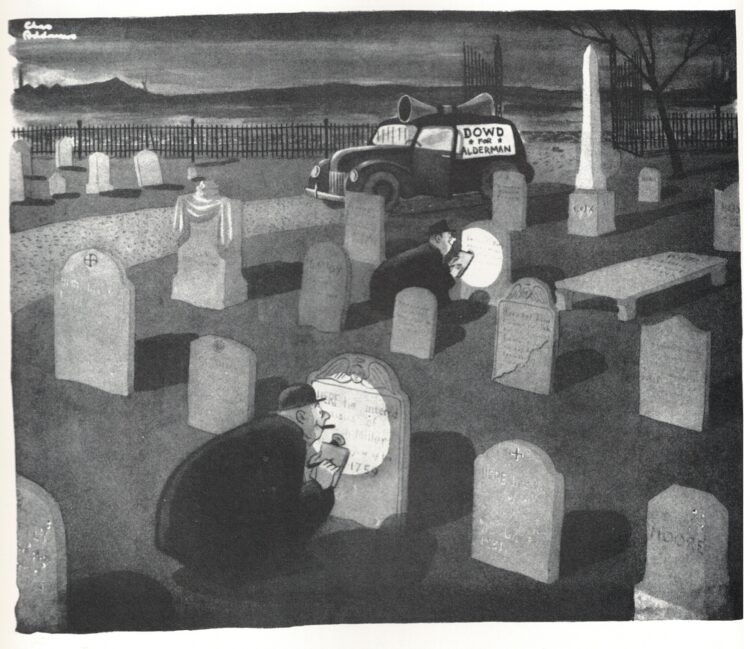
A black and white photograph of Charles Addams in a cemetery, reflecting his lifelong fascination with macabre themes and gothic settings.
Addams’s artistic talent was evident early on. He honed his skills by drawing cartoons for his Westfield High School student magazine and furthered his art education at Colgate University, the University of Pennsylvania, and the NY Grand Central School of Art. His early professional life took a decidedly morbid turn when he landed a job in 1933 retouching photos for True Detective Magazine. His task? To remove blood from crime scene photographs, a macabre form of virtual undertaker work that seems strangely fitting for the future creator of the Addams Family. He began contributing single-panel cartoons to The New Yorker in 1932, but it was in 1938 that he introduced the first of his macabre caricatures that would evolve into The Addams Family. This groundbreaking concept caught the attention of David Levy, ultimately leading to the creation of The Addams Family television show in the 1960s.
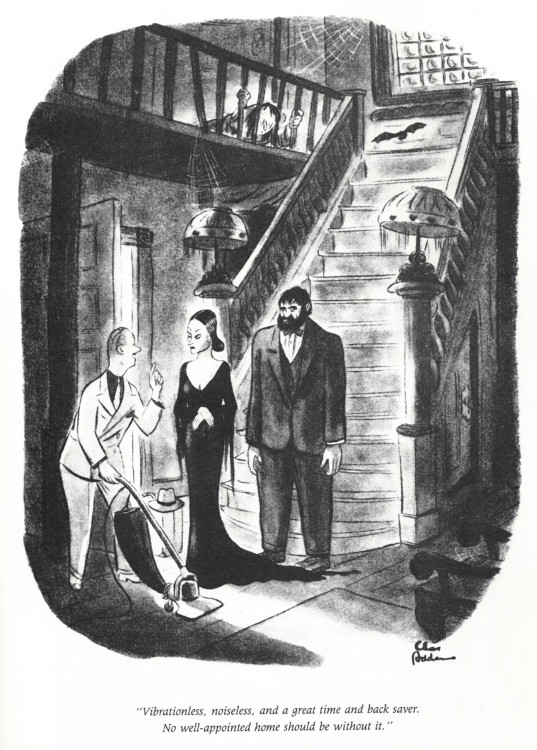 1938
1938
A vintage black and white New Yorker cartoon panel from 1938, likely one of the earliest depictions of Morticia Addams, showcasing Charles Addams’s original character design.
Despite the growing popularity of his Addams Family single-panel comics, Addams was paid modestly for his work at The New Yorker, earning around $35 per piece as a freelancer. During World War II, his talent took another darkly humorous turn when he was drafted to create instructional films about syphilis for the U.S. Army Signal Corps – a truly Addams-esque assignment.
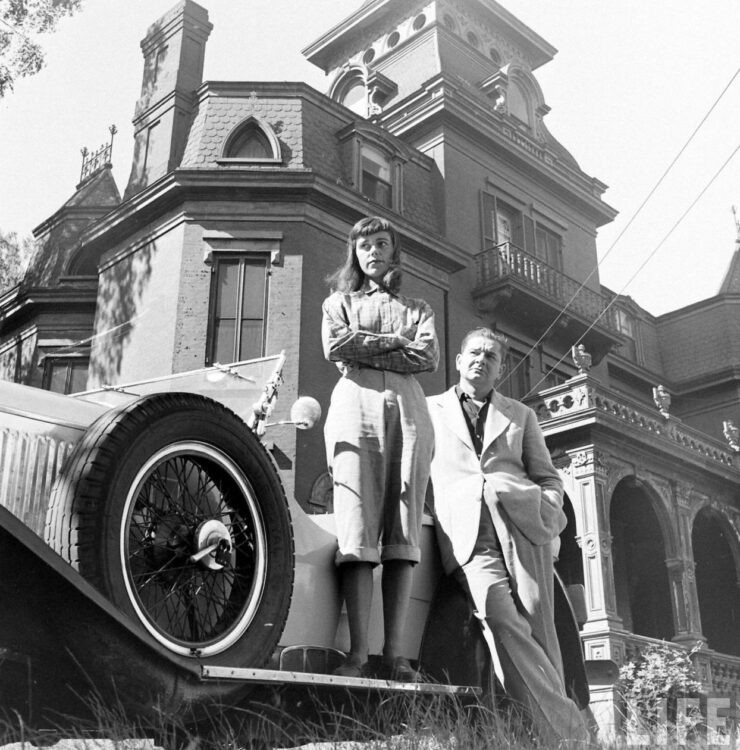
A black and white portrait of Barbara Jean Day, Charles Addams’s first wife, rumored to be the inspiration for Morticia Addams.
Addams’s personal life also seemed to mirror his macabre creations. His first wife, Barbara Jean Day, was famously said to bear a striking resemblance to Morticia Addams. Their marriage, however, ended after eight years, reportedly because Addams did not want children.
A black and white photograph from 1946 showing Charles Addams drawing a cartoon panel, with Barbara Jean Day, his first wife and Morticia inspiration, by his side.
This image from 1946 captures Chas at work, drawing a panel featuring Morticia, visibly modeled after Barbara. In the 1950s, Addams further expanded his comic work with a syndicated one-panel comic called Out of This World. He also cultivated friendships with fellow masters of the macabre, Ray Bradbury and Alfred Hitchcock. Hitchcock, a fan of Addams’s work, even subtly paid homage to the cartoonist in his 1959 film North by Northwest. In a memorable line, Cary Grant quips, “The Three of you together. Now that’s a picture only Charles Addams could draw,” acknowledging Addams’s distinctive and darkly humorous artistic style.
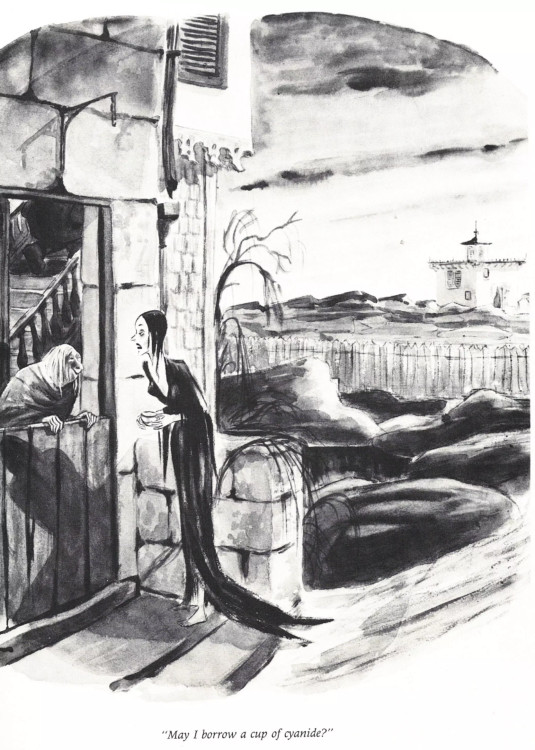 1941
1941
A 1941 New Yorker cartoon panel by Charles Addams featuring Morticia Addams and her Aunt, showcasing the evolving character designs and macabre humor.
The tone and intensity of Addams’s Addams Family panels were sometimes influenced by editorial preferences at The New Yorker. While editor William Shawn reportedly disliked jokes explicitly about death, Addams returned to his darker themes when Robert Gottlieb took over the role, suggesting a greater freedom to explore his signature morbid humor.
1942
A 1942 black and white cartoon panel of Gomez and Morticia Addams, exemplifying the sophisticated and darkly romantic relationship between the characters.
Addams’s second marriage was to attorney Estelle Barb in 1954. Intriguingly, Estelle persuaded him to grant her control of his TV and film rights, a decision that preceded their subsequent divorce.
 1955
1955
A black and white photograph from 1955, possibly of Estelle Barb, Charles Addams’s second wife, described as both good-looking and calculative.
She was described as being as “calculative” as she was “good-looking,” hinting at a shrewd business acumen. To cultivate his public persona and reinforce his macabre brand, Addams meticulously curated his home to reflect his dark humor. Whenever interviewers visited, he ensured they would encounter his embalming table, headsman’s axe, or collection of skulls – props designed to solidify the perception of him as delightfully “insane” and to cater to his fanbase’s expectations.
 1943
1943
A 1943 New Yorker cartoon panel featuring Lurch, the Addams Family butler, highlighting his towering figure and stoic demeanor in Addams’s signature style.
Adding to his eccentric image, Addams often joked that he chose his dog because it “hated children.” In a fittingly unconventional romantic gesture, he married his third wife, Tee, in a pet cemetery.
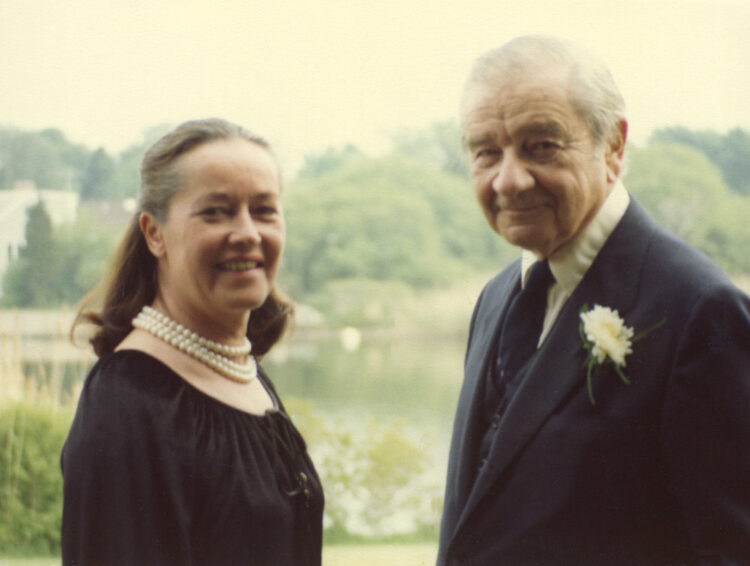
A photograph of Charles Addams with his third wife, Tee Addams, capturing a moment from their life together.
Their marriage lasted until his death, and Tee played a crucial role in preserving his legacy, becoming a source for many of the images and insights we have today of Charles Addams’s life and work.
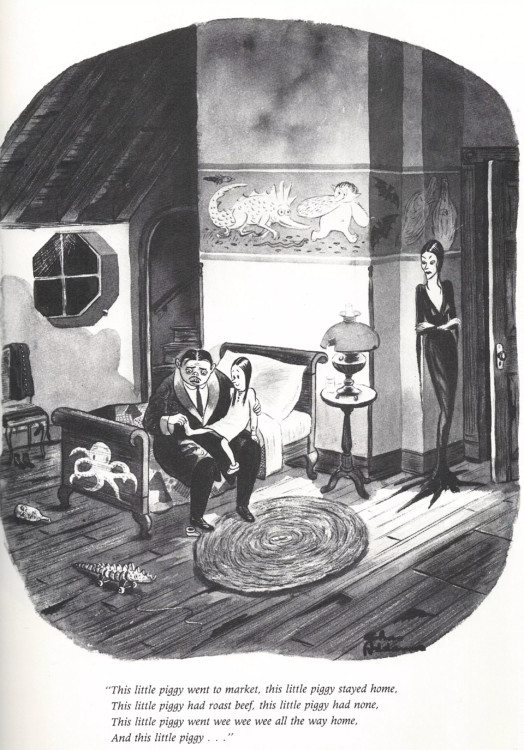 1945
1945
A 1945 New Yorker cartoon panel showcasing Gomez and Morticia Addams in a tender moment, revealing the darkly romantic and loving core of the family.
According to Tee, Chas possessed an intensely observant nature, meticulously studying details, such as the differences between freshwater and saltwater fish. His childhood fascination with knights remained, manifesting in a collection of suits of armor. His love for automobiles was also well-known. Fittingly, Charles Addams passed away peacefully from a heart attack behind the wheel of his parked Audi 4000, leaving behind a unique and enduring legacy. This legacy was carefully preserved by Tee, ensuring that Charles Addams’s darkly humorous genius continues to be celebrated.
 1945
1945
Another 1945 cartoon panel featuring Morticia Addams on the phone, highlighting her elegant and slightly eerie persona in Charles Addams’s characteristic style.
The 1960s TV show The Addams Family didn’t just borrow characters from Addams’s cartoons; it also adapted specific jokes and scenarios. A 1943 cartoon panel depicting Lurch carrying luggage while Morticia instructs a guest to “scream if you need anything” was directly adapted for episode 14, “Art and the Addams Family.”
 1950
1950
A 1950 New Yorker cartoon panel by Charles Addams, depicting a darkly humorous scene in a cemetery, showcasing his signature blend of macabre and wit.
Similarly, a 1945 cartoon showing Gomez and Morticia’s concern over Pugsley’s misguided interest in becoming a wholesome boy scout formed the basis for the subplot in the 1964 episode “Morticia and the Psychiatrist.”
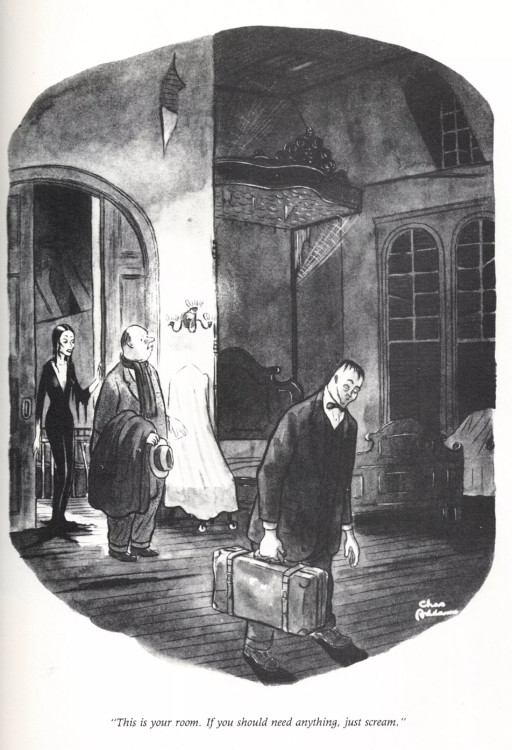 1943
1943
A 1943 New Yorker cartoon panel featuring Lurch carrying luggage, a joke that was directly adapted into the 1960s Addams Family TV series.
The 1965 episode “Christmas with the Addams Family” further drew inspiration from Addams’s comics, referencing a 1952 panel where Wednesday uses a bellows to ignite the fireplace, presumably to cremate Santa Claus upon his arrival down the chimney.
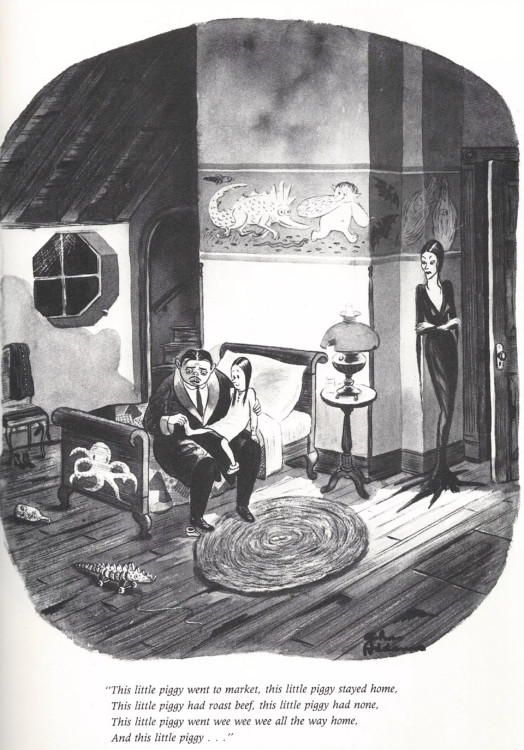 1945
1945
A 1945 New Yorker cartoon panel featuring Gomez and Morticia Addams expressing concern over Pugsley’s interest in the Boy Scouts, a plot point used in the TV series.
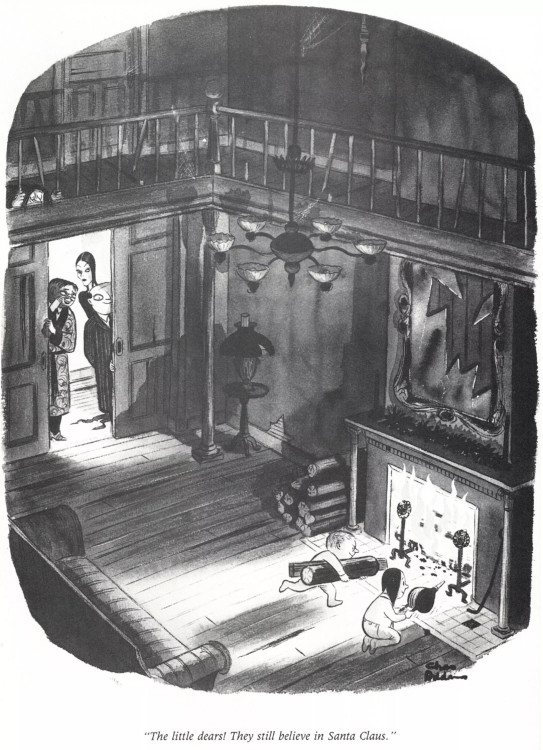 19521952
19521952
A 1952 New Yorker cartoon panel showing Wednesday Addams using a bellows on a fireplace, a darkly humorous take on holiday traditions.
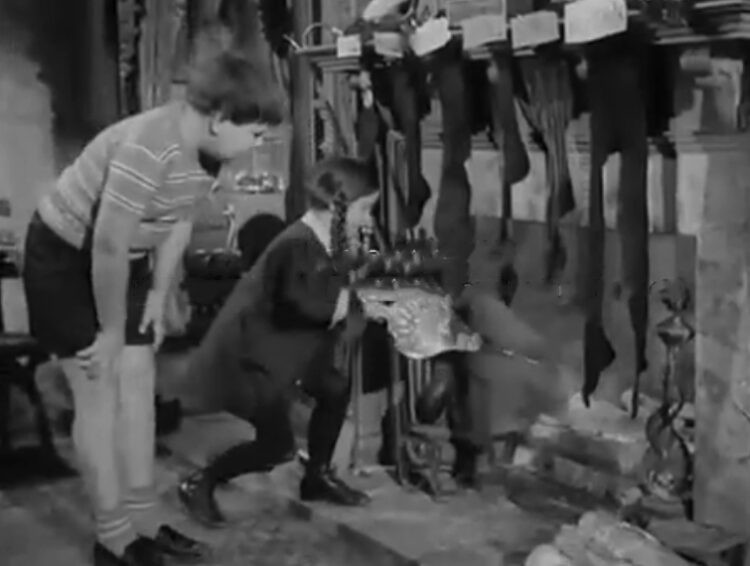
A promotional image for the “Christmas with the Addams Family” episode, visually capturing the macabre holiday spirit of the Addams Family.
Another panel depicts Morticia decorating a decidedly dead Christmas tree, embracing the family’s penchant for the unconventional.

A promotional still from “Christmas with the Addams Family” episode, featuring the Addams family gathered around a decorated, yet characteristically morbid, Christmas tree.
Going further back, a 1946 cartoon shows the Addams Family preparing a vat of scalding hot liquid for unsuspecting Christmas carolers, a scene hilariously recreated in the opening credits of the 1991 film.
 19461946
19461946
A 1946 New Yorker cartoon panel depicting the Addams Family preparing a vat of hot liquid for Christmas carolers, a classic example of their darkly humorous approach to holiday traditions.
As we anticipate future iterations of the Addams Family, whether in CGI or other formats, it’s crucial to remember that their foundation lies in the morbid genius of Charles Addams. So, let us raise a toast – be it with glasses, helmets, or swords – to Charles “Chas” Addams, the originator of this wonderfully weird and enduring family. Cheers to the master of macabre humor!
A portrait of Charles Addams, the creator of The Addams Family, celebrating his legacy and influence on dark humor and cartooning.
